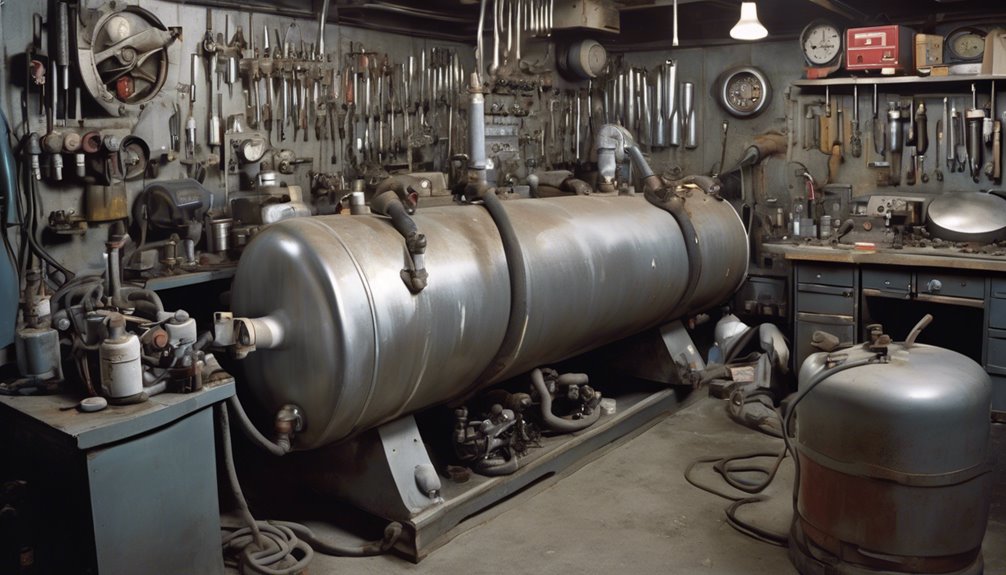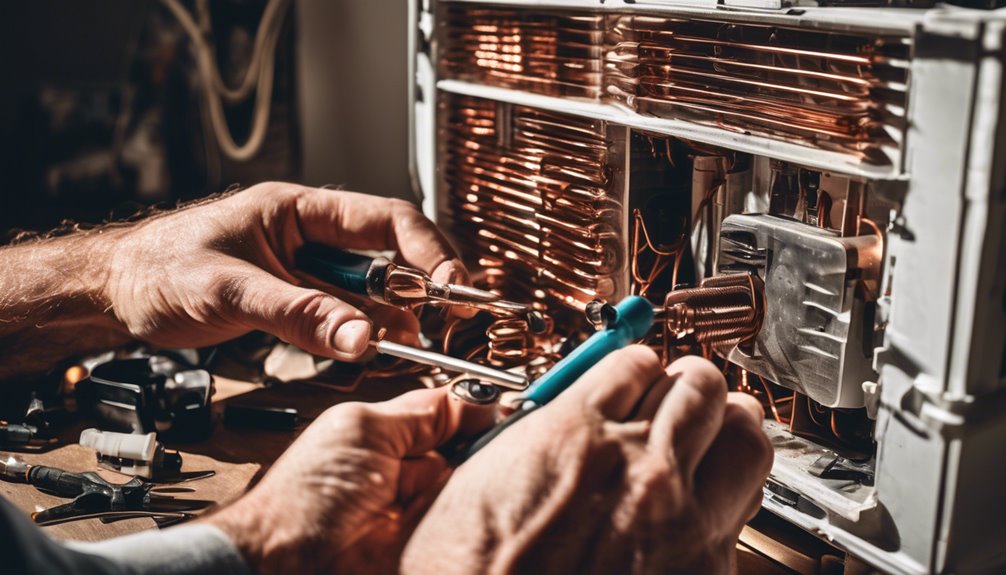When your AC starts blowing warm air or shows signs of reduced performance, it's likely that refrigerant loss is the culprit. You'll need to identify the source of the leak, which could be due to system failures, human errors, or signs of wear and tear. If you notice your AC isn't cooling efficiently, your energy bills are increasing, or it's taking longer to cool, it's time for a gas refill. By pinpointing the leak and addressing it promptly, you'll not only restore your system's efficiency but also prevent further damage – and that's just the beginning of what you'll discover.
Key Takeaways
- Identify the source of the refrigerant leak before refilling the gas to ensure a successful repair and prevent further damage.
- A thorough system inspection is necessary to detect signs of refrigerant leaks, such as oily streaks or residue, and worn or damaged components.
- Improper refrigerant handling can lead to environmental harm and health risks, so it's crucial to hire a certified technician for the job.
- Timely leak repair and refill can reduce energy bills, extend the system's lifespan, and improve air quality, promoting a healthier indoor environment.
- A refill and repair process involves evacuating remaining refrigerant, inspecting and repairing the system, and refilling with the correct type and amount of refrigerant.
Identifying Refrigerant Leaks
When it comes to AC gas refilling, identifying refrigerant leaks is a crucial step that can't be overlooked.
You'll need to inspect your system thoroughly to pinpoint the source of the leak. Start by checking for signs of refrigerant odor, which can indicate a leak in the system.
Next, perform a system inspection to identify any visible signs of damage or wear. Check the condenser coils, evaporator coils, and refrigerant lines for cracks, rust, or corrosion.
Look for oily streaks or residue, which can indicate refrigerant leaks. By taking these steps, you'll be able to identify refrigerant leaks and take the necessary steps to repair them before refilling the AC gas.
Causes of Refrigerant Loss
Refrigerant loss can occur due to various reasons, and understanding these causes is essential to prevent further loss and ensure efficient AC gas refilling.
When you're trying to identify the source of the problem, you'll want to consider system failures as a potential culprit. Worn-out valves, corroded pipes, and damaged compressors can all lead to refrigerant leaks.
Additionally, human errors during installation, maintenance, or repair can also cause refrigerant loss. You might've overlooked a loose connection, forgotten to tighten a valve, or accidentally damaged a component.
Signs Your AC Needs a Gas Refill
Now that you've identified the potential causes of refrigerant loss, it's time to recognize the signs that indicate your AC needs a gas refill.
If you notice that your AC isn't cooling your space as efficiently as it used to, it may be a sign that the refrigerant levels are low.
Other signs include increased energy bills, as your AC works harder to cool your space, and reduced gas efficiency.
You may also notice that your AC is taking longer to cool your space, or that it's not blowing cold air at all.
If you're experiencing any of these issues, it's likely that your AC's system performance is suffering, and a gas refill is necessary to get it running smoothly again.
The Refill and Repair Process
When you suspect a refrigerant leak in your AC, you'll need to identify the source before refilling the gas.
You'll use specialized equipment and techniques, such as soap bubble tests or electronic leak detectors, to pinpoint the leak.
Once you've located the issue, you can proceed with the refill and repair steps to get your AC running efficiently again.
Leak Detection Methods
To begin the refill and repair process, you must first identify the source of the AC gas leak, which can be a challenging task.
You'll need to employ effective leak detection methods to pinpoint the issue. Acoustic sensors can help you detect hissing sounds emitted by the leak, allowing you to narrow down the search area.
Infrared imaging is another useful technique, as it can visualize temperature differences, indicating the presence of refrigerant.
Refill and Repair Steps
Once the leak has been identified and isolated, you can proceed with the refill and repair process, which involves a series of critical steps to ensure a successful outcome.
First, you'll need to evacuate the remaining refrigerant from the system, taking care to follow strict Gas Safety guidelines to prevent accidents.
Next, Professional Technicians will inspect the system for any other leaks or damage, making repairs as needed.
After that, they'll refill the system with the correct type and amount of refrigerant.
Finally, they'll test the system to ensure it's running efficiently and safely.
Importance of Proper Refrigerant Handling
Proper refrigerant handling is crucial to ensure your safety and the environment's well-being.
When you hire a technician to refill your AC gas, make sure they've the necessary refrigerant certification. This certification ensures they've undergone proper technician training to handle refrigerants safely and efficiently.
Improper handling can lead to refrigerant leaks, which harm the environment and pose health risks. A certified technician will follow strict guidelines to contain and dispose of refrigerants responsibly.
They'll also ensure your AC system is leak-free and functioning optimally. Don't compromise on safety – always choose a certified technician for your AC gas refill and repair needs.
Benefits of Timely Leak Repair and Refill
By addressing AC gas leaks promptly, you'll not only prevent further damage but also reap significant benefits.
For instance, a timely repair and refill can lead to reduced energy bills, as your system won't have to work overtime to compensate for the lost coolant.
Additionally, you'll extend the life of your AC system, saving you from costly replacements down the line.
Reduced Energy Bills
Timely leak repair and refill can significantly slash your energy bills.
When your AC is low on refrigerant, it has to work harder to cool your space, consuming more energy. By repairing leaks and refilling the gas, you'll restore your AC's energy efficiency.
This means you'll use less power to achieve the same cooling effect, leading to substantial cost savings. As a result, you'll enjoy lower energy bills and reduce your carbon footprint.
Extended System Life
When you repair leaks and refill your AC's refrigerant, you're not only saving money on energy bills, but you're also giving your system a new lease on life.
By doing so, you're investing in system optimization, which ensures your AC operates efficiently and effectively.
This, in turn, leads to several benefits, including:
- Extended warranty: Many manufacturers require regular maintenance to keep the warranty valid.
- Reduced maintenance costs: A well-maintained system breaks down less often, reducing repair costs.
- Improved air quality: A leak-free system circulates clean air, promoting a healthier indoor environment.
- Increased system lifespan: Proper maintenance can add years to your AC's lifespan, delaying the need for replacement.
Frequently Asked Questions
Can I Refill My AC Gas Myself?
You're considering refilling your AC gas yourself, but remember, DIY safety is key. Without proper knowledge, you risk contaminating the system or causing harm. Ensure you're using high-quality gas to avoid compromising performance and efficiency.
How Long Does the Refill and Repair Process Take?
When you need a fix fast, you're wondering how long the process takes. Typically, it takes a few hours, but with rush service and emergency scheduling, you can get back up and running in no time, hassle-free.
What Is the Cost of AC Gas Refilling?
Savvy spenders, you're smart to scope out the costs! Generally, gas prices dictate the refill expense, which varies depending on your location and the type of gas. Refill regulations also impact the final bill, so you'll pay around $100 to $300, give or take.
Is AC Gas Refilling Covered Under Warranty?
You typically check your product's warranty duration to see if it's still valid, and if you're lucky, you might have extended coverage that'll save you money, but unfortunately, AC gas refilling is usually not included in the standard warranty.
Can I Use Any Type of Refrigerant in My AC?
You can't use just any refrigerant in your AC, as different types have specific compatibility requirements. If you don't choose the right one, you'll face compatibility issues that can damage your unit or even cause safety hazards.
Conclusion
You've made it to the end! By now, you know how crucial it is to address refrigerant leaks and refill your AC unit promptly. Did you know that a single pound of refrigerant can cause up to 1.9 tons of carbon dioxide equivalent emissions? That's a significant environmental impact! So, stay on top of your AC's maintenance, and don't hesitate to call a professional if you suspect a leak. Your wallet and the planet will thank you.



